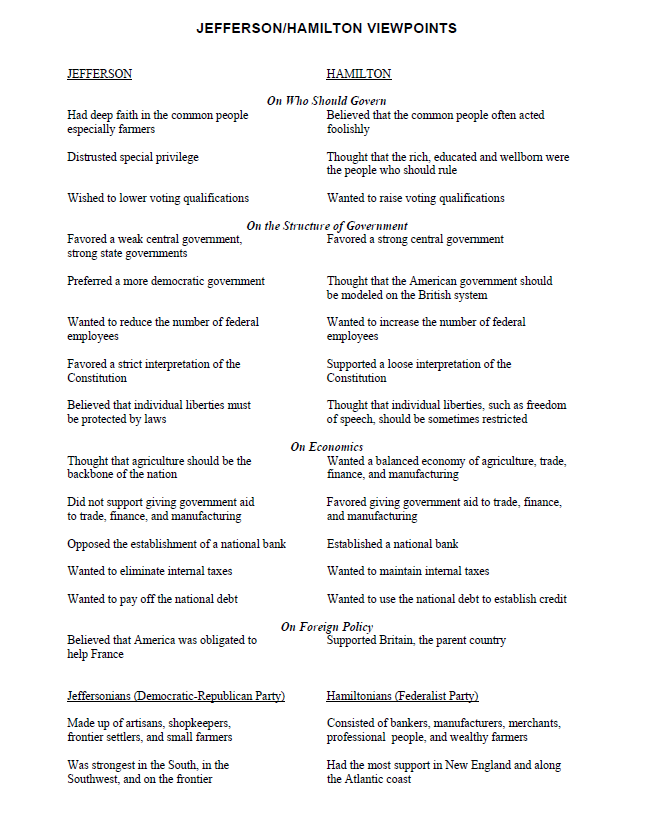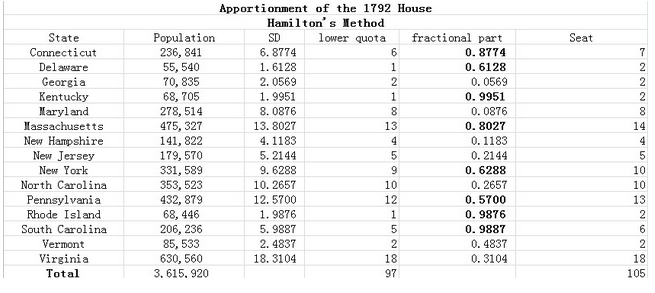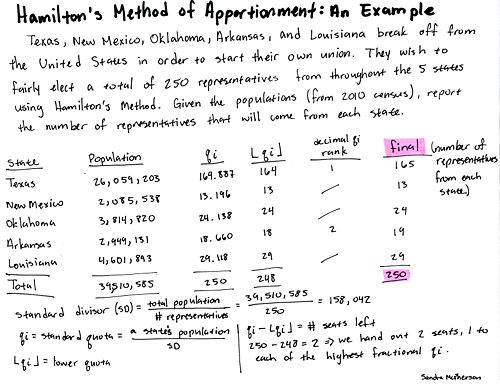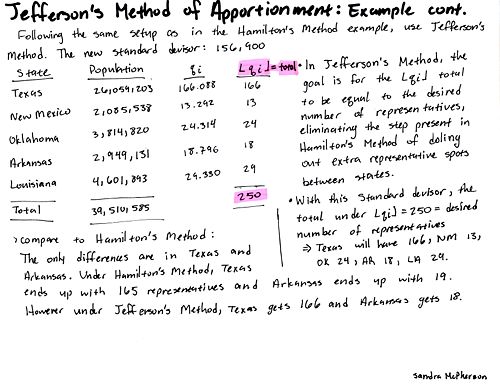| Line 1: | Line 1: | ||
| − | + | <br> | |
| − | [[ | + | |
| + | = Jefferson vs Hamilton, the US begins = | ||
| + | |||
| + | A team project for [[2013 Fall MA 279 Walther|MA279, Fall 2013]] | ||
| − | |||
| − | |||
---- | ---- | ||
| − | ==History== | + | |
| + | == History == | ||
| + | |||
'''Who is Jefferson?''' | '''Who is Jefferson?''' | ||
Thomas Jefferson (April 13, 1743 – July 4, 1826) was born in Albemarle County, Virginia. Having inherited a considerable landed estate from his father and high social standing from his mother, Jefferson began building Monticello when he was twenty-six years old. Having attended the College of William and Mary, Jefferson practiced law and served in local government at a magistrate, county lieutenant, and member of the House of Burgess in his early professional life. [1] Jefferson was a Founding Father of the Untied States, draftsman of the U.S. Declaration of Independence; the nation’s first secretary of state (1789 – 1794), second vice president (1797 – 1801), and the third president (1801 – 1809). As public official, historian, philosopher, and plantation owner, he served his country for over five decades. [2]<br> | Thomas Jefferson (April 13, 1743 – July 4, 1826) was born in Albemarle County, Virginia. Having inherited a considerable landed estate from his father and high social standing from his mother, Jefferson began building Monticello when he was twenty-six years old. Having attended the College of William and Mary, Jefferson practiced law and served in local government at a magistrate, county lieutenant, and member of the House of Burgess in his early professional life. [1] Jefferson was a Founding Father of the Untied States, draftsman of the U.S. Declaration of Independence; the nation’s first secretary of state (1789 – 1794), second vice president (1797 – 1801), and the third president (1801 – 1809). As public official, historian, philosopher, and plantation owner, he served his country for over five decades. [2]<br> | ||
| − | <br> | + | <br> '''Who is Hamilton?''' |
| − | ''' Who is Hamilton?''' | + | |
Alexander Hamilton (January 11, 1755 or 1757 – July 12, 1804) was born in Charlestown, the capital of the island of Nevis, in the Leeward Islands. Hamilton’s father James abandoned Rachel, his wife, and their two sons. Rachel contracted a severe fever and died on February 19, 1768, leaving Hamilton effectively orphaned. Hamilton arrived in New York and enrolled in King’s college in 1773. In 1775, when the Revolutionary War began, Hamilton became part of the New York Provincial Artillery Company and fought in the battles of Long Islands, White Plains and Trenton. Hamilton was a Founding Father of the United States, chief of staff to General Washington, one of the most influential interpreters and promoters of the Constitution, the founder of the nation’s financial system, and the founder of the first American political party.[3] | Alexander Hamilton (January 11, 1755 or 1757 – July 12, 1804) was born in Charlestown, the capital of the island of Nevis, in the Leeward Islands. Hamilton’s father James abandoned Rachel, his wife, and their two sons. Rachel contracted a severe fever and died on February 19, 1768, leaving Hamilton effectively orphaned. Hamilton arrived in New York and enrolled in King’s college in 1773. In 1775, when the Revolutionary War began, Hamilton became part of the New York Provincial Artillery Company and fought in the battles of Long Islands, White Plains and Trenton. Hamilton was a Founding Father of the United States, chief of staff to General Washington, one of the most influential interpreters and promoters of the Constitution, the founder of the nation’s financial system, and the founder of the first American political party.[3] | ||
| Line 21: | Line 23: | ||
<br> | <br> | ||
| − | + | <br> <br> [[Image:Jefferson v.s Hamilton.png]]<br> | |
| − | <br> | + | |
| − | [[Image:Jefferson v.s Hamilton.png]]<br> | + | |
'''Jefferson’s Method''' | '''Jefferson’s Method''' | ||
| Line 36: | Line 36: | ||
| − | Math | + | '''Math'''<br> |
| − | Jefferson’s Method [2] | + | |
| − | Calculate the Standard Divisor which is the quotient of the total population and the number of seats. | + | '''Jefferson’s Method [2]''' |
| − | Calculate the Standard Quota for each state which is the quotient of a state’s population and the Standard Divisor. | + | |
| − | Assign each state its Lower Quota which is its Standard Quota rounded down. | + | #Calculate the Standard Divisor which is the quotient of the total population and the number of seats. |
| − | If the sum of Lower Quotas is equal to the number of seats, you’re done. | + | #Calculate the Standard Quota for each state which is the quotient of a state’s population and the Standard Divisor. |
| − | Otherwise, find a Modified Divisor and respective Modified Quotas for which the sum of Modified Quotas is equal to the number of seats. | + | #Assign each state its Lower Quota which is its Standard Quota rounded down. |
| + | #If the sum of Lower Quotas is equal to the number of seats, you’re done. | ||
| + | #Otherwise, find a Modified Divisor and respective Modified Quotas for which the sum of Modified Quotas is equal to the number of seats.<span class="Apple-tab-span" style="white-space:pre"> </span> | ||
| + | |||
| + | |||
| + | |||
| + | '''Example''' | ||
[[Image:Jefferson.png]]<br> | [[Image:Jefferson.png]]<br> | ||
| − | Hamilton’s Method [2] | + | |
| + | |||
| + | '''Hamilton’s Method [2]''' | ||
| + | |||
Calculate the Standard Divisor which is the quotient of the total population and the number of seats. | Calculate the Standard Divisor which is the quotient of the total population and the number of seats. | ||
| − | Calculate the Standard Quota for each state which is the quotient of a state’s population and the Standard Divisor. | + | #Calculate the Standard Quota for each state which is the quotient of a state’s population and the Standard Divisor. |
| − | Assign each state its Lower Quota which is its Standard Quota rounded down. | + | #Assign each state its Lower Quota which is its Standard Quota rounded down. |
| − | If there are surplus seats, given them, one at a time, to states in descending order of the fractional parts of their Standard Quota. | + | #If there are surplus seats, given them, one at a time, to states in descending order of the fractional parts of their Standard Quota. |
| + | |||
| + | |||
| + | |||
| + | '''Example''' | ||
[[Image:Hamilton.PNG]]<br> | [[Image:Hamilton.PNG]]<br> | ||
| − | <br> | + | <br> [[Image:HamiltonsExampleRhea.McPherson.jpg|thumb|left|500px]] <br> Data for population is obtained from the 2010 census. [7] <br> [[Image:JeffersonsExampleRhea.McPherson.jpg|thumb|left|500px]] <br> |
| − | [[Image:HamiltonsExampleRhea.McPherson.jpg|thumb | + | |
| − | [[Image:JeffersonsExampleRhea.McPherson.jpg|thumb | + | |
| − | <br> | + | |
Sources: <br>http://www.monticello.org/site/jefferson/thomas-jefferson-brief-biography [1]<br>http://www.biography.com/people/thomas-jefferson-9353715 [2]<br>http://www.biography.com/people/alexander-hamilton-9326481 [3]<br>http://www.palomar.edu/ehp/history/sgrenz/Study%20Guides/JEFFERSON-HAMILTON%20VIEWPOINTS.pdf [4]<br>http://www.ams.org/samplings/feature-column/fcarc-apportion2 [5] | Sources: <br>http://www.monticello.org/site/jefferson/thomas-jefferson-brief-biography [1]<br>http://www.biography.com/people/thomas-jefferson-9353715 [2]<br>http://www.biography.com/people/alexander-hamilton-9326481 [3]<br>http://www.palomar.edu/ehp/history/sgrenz/Study%20Guides/JEFFERSON-HAMILTON%20VIEWPOINTS.pdf [4]<br>http://www.ams.org/samplings/feature-column/fcarc-apportion2 [5] | ||
| − | http://www.cut-the-knot.org/Curriculum/SocialScience/AHamilton.shtml [6] | + | http://www.cut-the-knot.org/Curriculum/SocialScience/AHamilton.shtml [6] <br>http://en.wikipedia.org/wiki/List_of_U.S._states_and_territories_by_population [7]<br><br> |
| − | <br>http://en.wikipedia.org/wiki/List_of_U.S._states_and_territories_by_population [7]<br><br> | + | |
| + | <br> Feiyan Chen, Sandy McPherson, Christopher Michael Wendt, Wenjun Zhang | ||
| − | |||
---- | ---- | ||
| − | [[ | + | |
| + | [[2013 Fall MA 279 Walther|Back to MA279, Fall 2013]] | ||
| + | |||
| + | [[Category:MA279Fall2013Walther]] [[Category:Math]] | ||
Revision as of 08:00, 23 November 2013
Jefferson vs Hamilton, the US begins
A team project for MA279, Fall 2013
History
Who is Jefferson?
Thomas Jefferson (April 13, 1743 – July 4, 1826) was born in Albemarle County, Virginia. Having inherited a considerable landed estate from his father and high social standing from his mother, Jefferson began building Monticello when he was twenty-six years old. Having attended the College of William and Mary, Jefferson practiced law and served in local government at a magistrate, county lieutenant, and member of the House of Burgess in his early professional life. [1] Jefferson was a Founding Father of the Untied States, draftsman of the U.S. Declaration of Independence; the nation’s first secretary of state (1789 – 1794), second vice president (1797 – 1801), and the third president (1801 – 1809). As public official, historian, philosopher, and plantation owner, he served his country for over five decades. [2]
Who is Hamilton?
Alexander Hamilton (January 11, 1755 or 1757 – July 12, 1804) was born in Charlestown, the capital of the island of Nevis, in the Leeward Islands. Hamilton’s father James abandoned Rachel, his wife, and their two sons. Rachel contracted a severe fever and died on February 19, 1768, leaving Hamilton effectively orphaned. Hamilton arrived in New York and enrolled in King’s college in 1773. In 1775, when the Revolutionary War began, Hamilton became part of the New York Provincial Artillery Company and fought in the battles of Long Islands, White Plains and Trenton. Hamilton was a Founding Father of the United States, chief of staff to General Washington, one of the most influential interpreters and promoters of the Constitution, the founder of the nation’s financial system, and the founder of the first American political party.[3]
Jefferson v.s Hamilton Viewpoints [4]
Jefferson’s Method
From 1790 to 1840, Jefferson’s Method for apportionment was used in the House of Representatives [5]. Around 1840, debate sprang up regarding the unfair advantage that large states seemed to have under Jefferson’s Method.
Hamilton’s Method
The apportionment method suggested by Alexander Hamilton was approved by Congress in 1791, but was subsequently vetoed by President Washington - in the very first exercise of the veto power by President of the United States. Hamilton's method was adopted by the US Congress in 1852 and was in use through 1911 when it was replaced by Webster’s method [6].
Math
Jefferson’s Method [2]
- Calculate the Standard Divisor which is the quotient of the total population and the number of seats.
- Calculate the Standard Quota for each state which is the quotient of a state’s population and the Standard Divisor.
- Assign each state its Lower Quota which is its Standard Quota rounded down.
- If the sum of Lower Quotas is equal to the number of seats, you’re done.
- Otherwise, find a Modified Divisor and respective Modified Quotas for which the sum of Modified Quotas is equal to the number of seats.
Example
Hamilton’s Method [2]
Calculate the Standard Divisor which is the quotient of the total population and the number of seats.
- Calculate the Standard Quota for each state which is the quotient of a state’s population and the Standard Divisor.
- Assign each state its Lower Quota which is its Standard Quota rounded down.
- If there are surplus seats, given them, one at a time, to states in descending order of the fractional parts of their Standard Quota.
Example
Data for population is obtained from the 2010 census. [7]
Sources:
http://www.monticello.org/site/jefferson/thomas-jefferson-brief-biography [1]
http://www.biography.com/people/thomas-jefferson-9353715 [2]
http://www.biography.com/people/alexander-hamilton-9326481 [3]
http://www.palomar.edu/ehp/history/sgrenz/Study%20Guides/JEFFERSON-HAMILTON%20VIEWPOINTS.pdf [4]
http://www.ams.org/samplings/feature-column/fcarc-apportion2 [5]
http://www.cut-the-knot.org/Curriculum/SocialScience/AHamilton.shtml [6]
http://en.wikipedia.org/wiki/List_of_U.S._states_and_territories_by_population [7]
Feiyan Chen, Sandy McPherson, Christopher Michael Wendt, Wenjun Zhang






